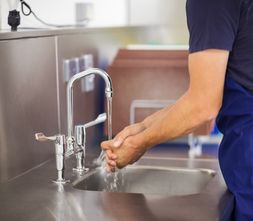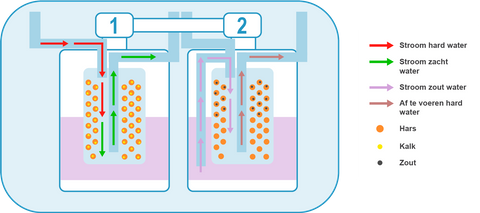Water treatment and water softening
Do you live in an area with hard water? Then a water treatment may be necessary to extend the life of your appliances.
Hard water is not unhealthy, but the presence of too much calcium and magnesium can cause serious limescale on your installations and equipment.
This is not only detrimental to the life of your devices, they will also render less.
The solution to counteract this limescale is the installation of a water softener. This ensures that your water is treated, so that your electrical appliances last longer and as a result of which the taps and sanitary installations show less limescale. A small investment with a big impact!

Water softener operation

Water softeners operating on the principle of ion exchange are most common. In a cylinder with resin granules, the calcium and magnesium ions in the water are exchanged for sodium ions. The water is thus effectively descaled by the resin granules.
If the resin granules are saturated, their performance diminishes and the resin cylinder must be rinsed or regenerated. Usually this is done automatically via a salt reservoir. The brine rinses the lime and magnesium from the resin and is discharged through the sewer. After regeneration, the resin filter is clean and the ion exchange can again take place optimally. Water softeners based on ion exchange is considered to be the most efficient.
Payback quickly
If the water in your area is very hard, you will automatically have to recoup the costs of a water softener. On average, you pay around € 1000 to € 1250 for a water softener, including installation. The cleaning salt with which you have to refill the device every now and then € 12.50 per 25 kilos. On the other hand, your appliances live 30% longer and this concerns, for example, your boiler, washing machine, dishwasher, kettle and coffee maker. They will use less electricity because the water can heat up faster. You need less detergent and shampoo and you no longer need to buy descalers. All in all, you can recoup your money because you only have to replace your electrical appliances much later and you have to buy fewer cleaning products.


Drinking water system
A water filter works on the basis of reverse osmosis. First, residues of metal and sand are filtered out of the water, then small elements such as viruses and bacteria are also removed from the water. Healthy minerals do remain in the water for healthy drinking water. These water filters are placed on the supply of cool water in the kitchen, this can be a separate tap if desired.
If you assume a household of four people, with a consumption of one and a half liters of drinking water per day, the annual use will amount to almost 2200 liters of water. At a price of 50 cents for a liter of water from a bottle, this will amount to almost 1100 euros. If we keep an average price of € 0.003 for a liter of tap water, the costs will be € 6.60 on an annual basis. With a drinking water system you can therefore save more than 1000 euros on the use of drinking water. You must of course also count the purchase of a drinking water system.


COPYRIGHT © ALLE RECHTEN VOORBEHOUDEN G.Vanhoyweghen